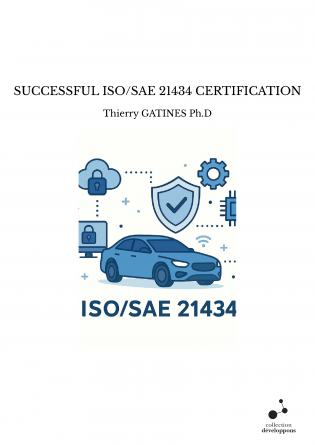ISO/SAE 21434 successful certification: the global benchmark for automotive cybersecurity
In an era where connected vehicles are reshaping mobility, protecting digital systems has become a strategic necessity.
The ISO/SAE 21434 standard sets the international framework for automotive cybersecurity management throughout the entire vehicle life cycle.
The book ISO/SAE 21434 Successful Certification is a comprehensive and operational guide, designed to help manufacturers, suppliers, and service providers implement the standard and achieve certification effectively.
Why ISO/SAE 21434 is essential for secure and connected mobility
The digital transformation of the automotive industry brings tremendous opportunities — but also significant risks.
Cyberattacks targeting vehicles can compromise safety, data integrity, and consumer trust.
To address these challenges, ISO/SAE 21434 defines a structured approach to managing cybersecurity risks from design to decommissioning.
It ensures that cybersecurity is embedded in every stage — design, production, operation, and maintenance.
Moreover, it aligns with the UNECE R155 regulation, making it an essential standard for regulatory compliance.
By implementing ISO/SAE 21434, organisations can anticipate threats, protect critical assets, and enhance their market credibility.
As a result, ISO/SAE 21434 Successful Certification becomes a strategic tool, helping automotive players turn cybersecurity into a core pillar of quality and trust.
A step-by-step guide to achieving ISO/SAE 21434 certification
The book provides a clear and structured roadmap for implementing ISO/SAE 21434 within the automotive ecosystem.
Each chapter walks readers through the certification process, combining theoretical foundations with practical applications.
The main stages include:
-
Understanding the requirements: interpret the standard’s clauses and adapt them to organisational processes.
-
Risk assessment: identify potential cyber threats, vulnerabilities, and their possible impacts.
-
Integration into design: embed cybersecurity controls during vehicle development.
-
Operational management: ensure continuous monitoring and response throughout the product life cycle.
-
Audit preparation: conduct internal reviews, assess compliance, and prepare for external certification.
Through this structured approach, organisations gain the tools to build resilient systems, reduce risks, and demonstrate compliance to regulators and clients.
In addition, the guide encourages a proactive cybersecurity culture across all levels of the organisation.
Practical tools, case studies and expert feedback
To make the certification journey easier, ISO/SAE 21434 Successful Certification provides a wide range of practical tools and templates.
These include risk assessment matrices, cybersecurity plans, compliance checklists, and incident response frameworks.
Each chapter features real-world case studies, illustrating how leading automotive companies have implemented ISO/SAE 21434 successfully.
These examples help readers understand best practices, overcome implementation challenges, and tailor solutions to their specific context.
Moreover, the book includes KPIs and self-assessment tools to measure progress and ensure continuous improvement.
Thus, it serves as both a reference manual and a hands-on operational guide, transforming complex cybersecurity principles into actionable steps.
A key certification for trust, resilience and market leadership
Obtaining ISO/SAE 21434 certification demonstrates a company’s commitment to cybersecurity and innovation.
It enhances trust among customers, partners, and regulators by showing that digital risks are identified, controlled, and monitored.
Furthermore, certification gives automotive players a competitive advantage, ensuring compliance with global requirements and strengthening their brand reputation.
It also contributes to a safer and more resilient mobility ecosystem, where cybersecurity is integrated from concept to deployment.
Therefore, ISO/SAE 21434 Successful Certification stands as a strategic guide, helping organisations align technical excellence, safety, and digital confidence.
Fiches techniques

Normes ISO disponibles
par thierry.gatines | Août 11, 2025 | Fiches techniques

Audit ISO les erreurs à éviter
par thierry.gatines | Août 11, 2025 | Fiches techniques

Les étapes clés de la certification ISO
par thierry.gatines | Août 11, 2025 | Fiches techniques

